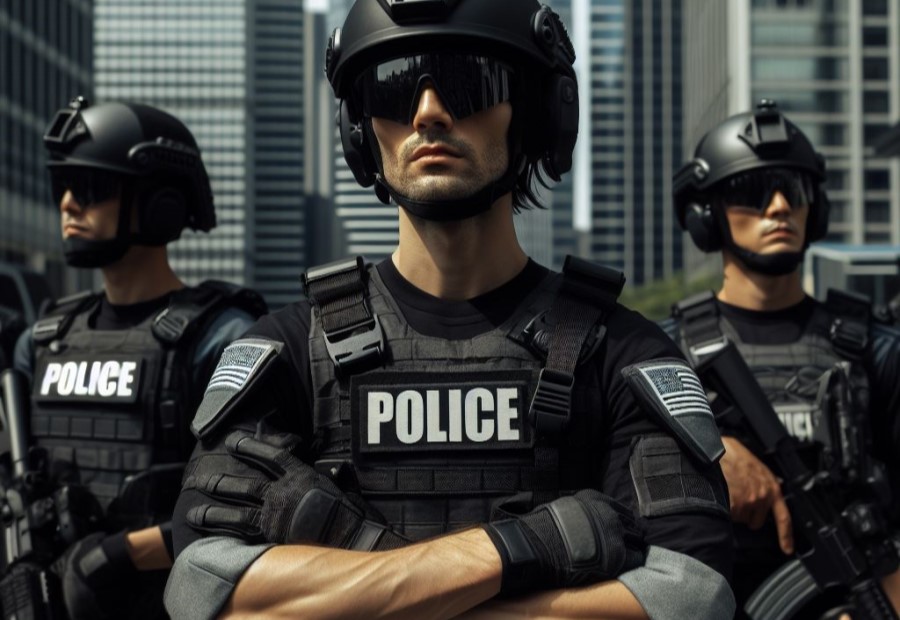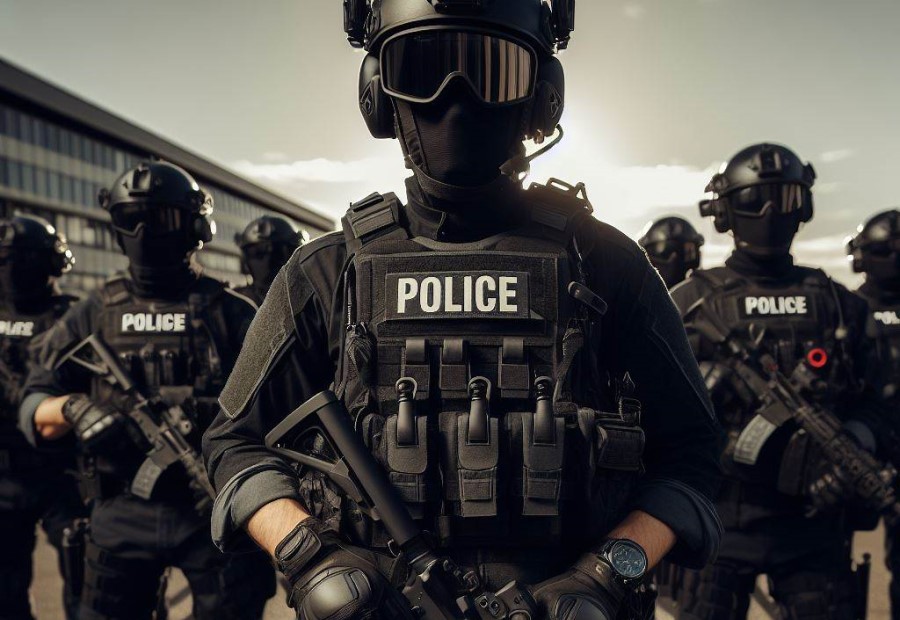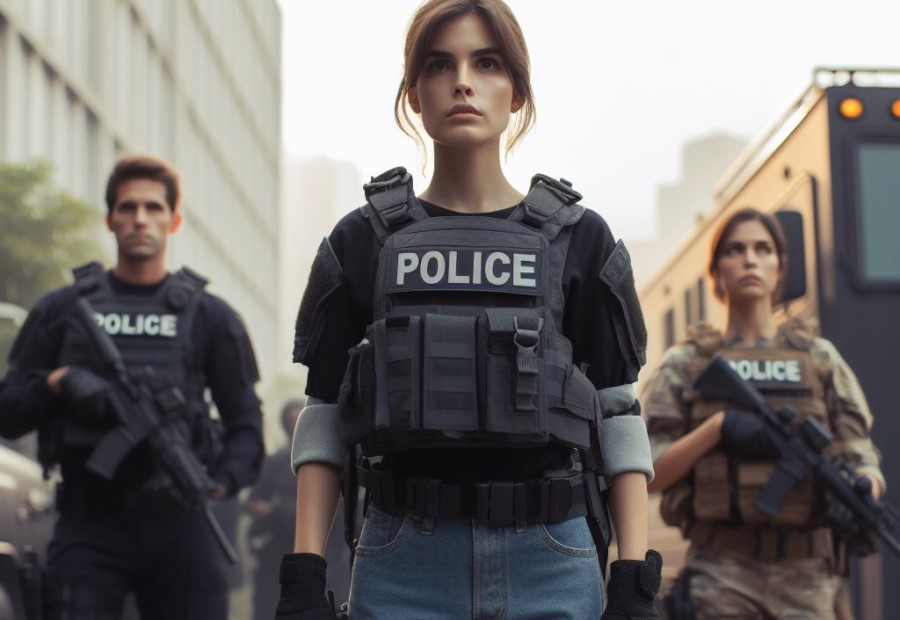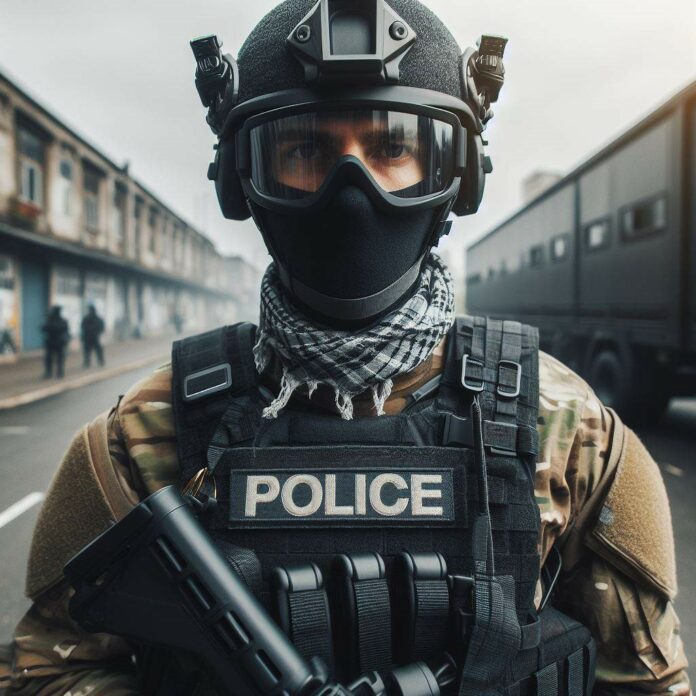Tactical gear, which includes items like body armor, tactical vests, helmets, gas masks, and riot shields, provides essential protection and enhances the overall performance of law enforcement personnel.
The distinct appearance of officers in tactical gear serves as a visible symbol of their commitment to public safety and their preparedness to handle challenging law enforcement scenarios.
However, it is important to acknowledge that the use of tactical gear by police has been a subject of controversy, particularly regarding the militarization of police and its impact on community relations.
By gaining a deeper understanding of police tactical gear, we can examine its benefits and potential drawbacks in order to foster informed conversations and positive change.
What is Tactical Gear?

Definition of Tactical Gear
Tactical gear, as per its definition, refers to the specialized equipment and accessories utilized by police officers to enhance their effectiveness and safety in high-risk situations.
This gear is specifically designed to provide protection, functionality, and convenience during law enforcement operations.
The purpose of tactical gear is to ensure that police officers have the necessary equipment to effectively and safely carry out their duties. This includes items such as body armor, tactical vests, helmets, gas masks, riot shields, and more.
By wearing tactical gear, police officers can significantly enhance their operational effectiveness.
They have immediate access to essential equipment, allowing them to conveniently and securely carry necessary items like communication devices, weapons, and protective gear.
While the use of tactical gear by police has generated controversies and discussions, particularly regarding the militarization of police and its impact on community relations, it is important to remain focused on the definition of tactical gear and its intended purpose in enhancing officer safety and operational effectiveness.
Purpose of Tactical Gear
Tactical gear serves a specific purpose in law enforcement operations. Its primary function is to ensure the safety and effectiveness of police officers in high-risk situations.
By providing essential protection and equipment, tactical gear allows officers to perform their duties with confidence and preparedness.
The purpose of tactical gear is to enhance officer safety. This includes protecting them from physical harm and providing necessary tools to handle dangerous situations.
Body armor, tactical vests, and helmets offer vital protection against firearms, edged weapons, and blunt force trauma. Gas masks and respirators safeguard officers from hazardous substances, ensuring their well-being in environments with chemical threats.
Another purpose of tactical gear is to enhance operational effectiveness. The equipment allows officers to carry essential tools and supplies conveniently, improving their efficiency in the field.
Gear such as holsters, communication devices, and flashlights enable quick and effective responses to incidents. By having the necessary resources readily available, officers can execute their duties with precision and confidence.
Preparedness for high-risk situations is a crucial aspect of tactical gear. Riot shields provide a barrier against projectiles and maintain crowd control during protests or civil unrest.
These tools give officers the ability to de-escalate volatile situations while maintaining self-defense capabilities.
Why Do Police Wear Tactical Gear?

Ensuring Officer Safety
Ensuring officer safety is a crucial aspect when it comes to police tactical gear.
- Body armor: One of the main components of tactical gear is body armor, which plays a vital role in ensuring officer safety. It provides protection against firearms and other potentially harmful objects, minimizing the risk of injury to officers.
- Tactical vests: Tactical vests are specifically designed to carry essential equipment, such as ammunition, firearms, and communication devices, while also prioritizing officer safety by offering additional protection for vital areas of the body.
- Helmets and headgear: Helmets and headgear are essential for officer safety as they offer protection for the head and face, safeguarding officers from head injuries or projectiles during confrontations.
- Gas masks and respirators: In situations involving chemical agents or toxic substances, gas masks and respirators are crucial in ensuring officer safety. They help officers breathe safely and avoid the harmful effects of such substances.
- Riot shields: Riot shields are a vital component of police tactical gear as they provide essential protection against projectiles, thrown objects, and physical attacks during crowd control or riot situations, ultimately ensuring the safety of officers.
By utilizing these various forms of tactical gear, police can effectively enhance their safety and protect themselves from potential threats they may encounter while carrying out their duties.
Enhancing Operational effectiveness
Tactical gear plays a crucial role in enhancing the operational effectiveness of police officers by providing them with the tools and equipment needed to perform their duties safely and efficiently.
The right gear can improve officer safety, situational awareness, and overall performance. When selecting tactical gear, it’s crucial to consider the specific needs of the officers and the nature of their operations.
Regular training and familiarization with the equipment are also essential to ensure its effective use in the field.
Preparedness for High-Risk Situations
- Assessing the threat level is crucial for police officers when entering high-risk situations. They must carefully evaluate the level of danger by considering factors such as the presence of firearms, the number of suspects, and the potential for violence.
- Developing a well-thought-out tactical plan is essential based on the assessment of the threat level. This plan should include detailed strategies for approaching the situation, positioning the team members, and ensuring coordination among them.
- Ensuring preparedness, police officers must equip themselves with the appropriate tactical gear. This includes essential items such as body armor, tactical vests, helmets and headgear, gas masks and respirators, and riot shields. These gears provide protection and enhance officers’ ability to navigate high-risk situations effectively.
- Participating in specialized training programs is crucial to enhance officers’ preparedness for high-risk situations. By focusing on tactics and strategies specific to such circumstances, officers can develop the necessary skills and increase their overall readiness.
- Effective communication plays a vital role in handling high-risk situations. Therefore, officers should undergo training to develop strong communication skills and utilize tools like radios and hand signals to maintain constant communication with their team members, ensuring effective coordination and decision-making.
- Another aspect of preparedness is situational awareness. Officers need to be constantly aware of their surroundings, assessing the environment for any changes and potential threats that may arise in high-risk situations.
- Working as a team is critical in high-risk situations. Officers should cultivate a strong teamwork mentality, understanding their designated roles and responsibilities within the team. This teamwork mindset enhances coordination and greatly increases the chances of a successful outcome.
Types of Tactical Gear Used by Police

Body Armor
When it comes to police tactical gear, body armor is a crucial component that provides essential protection to officers in high-risk situations. Here are some key points to know about body armor:
- Level of protection: Body armor is available in various levels, ranging from Level I to Level IV. These levels offer different degrees of protection against bullets and other threats.
- Materials used: Body armors are mostly made from advanced materials like lightweight and flexible Kevlar. Kevlar offers excellent ballistic resistance while ensuring comfortable wearability.
- Styles: Body armor comes in different styles, including concealable vests that can be worn under clothing and external carriers that can be worn over clothing. The choice of style depends on the officer’s preference and the nature of their duties.
- Additional features: Some body armors come with additional features such as trauma plates or pouches for carrying extra equipment like magazines or medical supplies.
- Maintenance and care: Proper maintenance and regular inspection are crucial to uphold the integrity of body armor. This includes checking for any signs of wear, replacing expired armor components, and following the cleaning instructions provided by the manufacturer.
When selecting body armor, it is essential to consider factors such as the required level of protection for the officer’s specific role, as well as comfort and mobility.
Updating and replacing body armor regularly, according to the manufacturer’s recommendations, is also vital to ensure continuous and adequate protection for law enforcement officers.
Always remember, the safety and well-being of officers depend on reliable and high-quality body armor.
Tactical Vests
Tactical vests are an essential piece of equipment for police officers. These Tactical Vests offer both protection and functionality, allowing officers to carry necessary gear and have quick access to it when needed.
- Protection: Tactical vests are designed to provide ballistic protection to the wearer. They are made with durable materials that can withstand bullets, shrapnel, or other potential threats. The Tactical Vests are designed to distribute the impact across the wearer’s body, minimizing injury.
- Storage: Tactical vests have multiple pockets and compartments that allow officers to carry various equipment such as magazines, handcuffs, radios, and first aid kits. This keeps essential items easily accessible and organized.
- Modularity: Tactical vests have a modular design that allows officers to customize the placement of pouches and accessories according to their needs. This flexibility ensures that officers can carry the specific gear required for each operation or situation.
- Mobility: Tactical vests are designed to be lightweight and ergonomic, allowing officers to move freely and comfortably. They are adjustable to fit different body types, ensuring a secure and snug fit without hindering mobility.
- Identification: Tactical vests often have areas for attaching patches or badges, enabling officers to display their identification and rank clearly. This helps with command and communication during high-pressure situations.
Tactical vests are crucial in providing the necessary protection and functionality for police officers during their operations. They ensure officer safety and enhance operational effectiveness by keeping essential gear accessible and organized.
Helmets and Headgear
Helmets and headgear are crucial components of police tactical gear that are indispensable for officer safety and providing protection in high-risk situations.
- Police helmets are specifically designed to shield the head from impact, flying debris, and projectiles. They typically feature a hard outer shell and a padded interior for enhanced comfort. In situations such as riots, crowd control, and active shooter scenarios, helmets play a critical role.
- Face shields are often integrated with helmets to provide additional protection to the face and eyes. Constructed from shatter-resistant materials, they effectively safeguard officers from projectiles, chemical agents, and other potential hazards.
When selecting helmets and headgear, it is essential to consider their impact resistance rating, weight, level of comfort, and compatibility with other tactical gear.
Additionally, aspects such as ventilation, communication capabilities, and the ability to accommodate additional accessories may also influence the choice of headgear.
Gas Masks and Respirators
Gas Masks and Respirators are essential pieces of tactical gear used by the police in certain situations. These equipment ensure the safety and protection of officers as they deal with various threats and hazards they may encounter.
- Protection from Chemical Agents: Gas Masks and Respirators are designed to provide a barrier against harmful chemical agents, such as tear gas, pepper spray, and other toxic substances. They effectively filter the air, preventing the inhalation of these dangerous materials.
- Preservation of Breathing: These Gas Masks and Respirators have filters that remove harmful particles and pollutants from the air, enabling the officers to breathe safely in environments with poor air quality or during emergencies where the air may be contaminated.
- Prevention of Respiratory Issues: Gas Masks and Respirators protect officers from developing respiratory problems or diseases caused by exposure to harmful gases, fumes, smoke, or airborne contaminants.
- Enhanced Visual Acuity: Many Gas Masks and Respirators are equipped with an anti-fog system to ensure clear visibility, allowing officers to navigate through challenging situations without hindrance.
- Emergency Preparedness: Gas Masks and Respirators enable police officers to effectively respond to high-risk situations, including riots, protests, and hazardous incidents, ensuring their readiness and safety.
Gas Masks and Respirators play a vital role in providing officers with the necessary protection against various threats and hazards they face while maintaining law and order.
These essential pieces of gear are crucial for the safety and well-being of police officers in challenging and potentially dangerous situations.
Riot Shields
Riot shields are a vital piece of tactical gear used by the police during protests, riots, and other high-risk situations.
These shields are made of strong and durable materials like polycarbonate or fiberglass, capable of withstanding impact from projectiles and blunt force objects.
Riot shields are designed to provide protection to officers by forming a barrier between them and aggressive individuals or crowds.
Controversies surrounding Police Tactical Gear

Militarization of Police
Militarization of police continues to be a worrisome issue in law enforcement that has garnered attention in recent years.
The adoption of military equipment, tactics, and mindset by civilian police forces, known as the militarization of police, has sparked concerns about the proper level of force and the perception of the police within communities.
Instead of using terms like “should” or “must,” thoroughly examining the facts surrounding this topic is paramount.
The term “Militarization of Police” refers to the incorporation of military equipment, tactics, and mindset by civilian police forces. This encompasses the utilization of armored vehicles, assault rifles, and other heavy weapons typically associated with the military.
Critics express concerns that the use of such equipment may create a hostile and intimidating atmosphere, erode trust between communities and the police, and escalate tensions during protests or demonstrations.
Employing military-style gear has the potential to give the impression that the police are ready to wield excessive force or view civilians as potential adversaries. This perception can further strain community relations and impede effective policing.
Striking the right balance is crucial. While it is essential for the police to possess the necessary tools to ensure public safety, it is important to ensure that the use of tactical gear is proportionate to the situation and employed as a last resort rather than an initial response.
Addressing concerns about militarization necessitates transparency on the part of police departments regarding the procurement and utilization of tactical gear.
This encompasses having clear policies for its deployment, offering training to officers, and regularly reviewing its usage to ensure alignment with the principles of community policing.
Understanding the concerns surrounding the militarization of police allows for informed discussions on the appropriate use of tactical gear and the nurturing of positive community relations.
Police departments must consistently evaluate their tactics and equipment to ensure they are serving the best interests of the communities they are entrusted to protect.
Perception and Community Relations
In recent years, the perception and community relations surrounding the use of police tactical gear have become important considerations.
The public’s perception of law enforcement officers wearing tactical gear can sometimes be negative, leading to strained community relations.
Law enforcement agencies must address this issue by improving transparency and communication with the community to ensure a better understanding of why police wear tactical gear.
It is crucial to educate the public about the purpose and necessity of tactical gear to overcome any misconceptions.
Community engagement programs and initiatives can help foster trust and promote positive relationships between the police and the community.
It is essential to involve community leaders, organizations, and residents in discussions about the use of tactical gear and its role in ensuring public safety.
By actively listening to community concerns and addressing them, law enforcement agencies can improve community relations.
This can include providing information about the training officers receive in using tactical gear, as well as emphasizing that its use is primarily for enhancing officer safety and operational effectiveness in high-risk situations.
Building a positive perception and fostering strong community relations requires ongoing efforts, collaboration, and open dialogue.
Law enforcement agencies must work towards building trust and understanding to ensure that the use of tactical gear is seen as a necessary tool for maintaining public safety rather than as an indication of oppressive or militarized policing.
Frequently Asked Questions
Why do police wear tactical gear?
Police officers wear tactical gear to protect themselves and enhance their capabilities in various law enforcement situations. This gear includes body armor, gloves, flashlights, Narcan, and eye protection.
It also includes weapons such as firearms, batons, handcuffs, and pepper spray. Tactical gear allows officers to be prepared for potential dangers and to effectively carry out their duties.
How does wearing tactical gear affect police officers?
Wearing tactical gear can have both physical and practical effects on police officers. The weight of the equipment, which can add 20 pounds or more, can lead to musculoskeletal damage and restrict movement.
This can impact an officer’s ability to perform tasks and even cause long-term health issues. Additionally, equipment that is not properly designed or fitted can be uncomfortable, unsafe, and cause discomfort or skin abrasions.
What are the challenges faced by female police officers regarding tactical gear?
Female police officers face specific challenges when it comes to wearing tactical gear. The weight of the equipment is a higher percentage of their body weight compared to male officers.
Utility belts can be especially hard for women due to spatial limitations on their waists. Improper fit and positioning of tools and holsters can cause discomfort and even nerve damage.
Moreover, traditional vests and body armor may not be properly designed for the female body, leading to issues such as improper fit, riding up, and restricted range of motion. Researching brands that provide the best solutions for female officers is important.
What are the solutions to lighten the burden of tactical gear on police officers?
To lighten the burden of tactical gear on police officers, several measures can be taken. One solution is to use synthetic materials and distribute the weight with more ergonomic designs for belts and vests.
This can reduce hip and lower back pain and allow for freer arm movement. Properly measured and fitted vests are also important to avoid discomfort and restricted range of motion.
Additionally, implementing strength and conditioning programs, adjusting patrol shifts for adequate rest, and promoting physical fitness, healthy weight, good nutrition, and sleep can mitigate the negative impacts of heavy gear on officers’ bodies.
What is the militarization of police, and what are its implications?
The militarization of police refers to the use of military equipment, tactics, and mindset by law enforcement officers. This includes the use of military-grade weapons, armored vehicles, and SWAT teams.
It is associated with a more aggressive style of law enforcement and has been a subject of concern for civil liberties organizations. Studies have shown that militarized police forces are more likely to have violent encounters with the public, regardless of crime rates.
The militarization of protest policing has also become evident, with the use of rubber bullets, tear gas, and other military tactics.
International examples of police militarization include Brazil, Canada, Germany, Indonesia, Mexico, and historical cases in Ireland and Northern Ireland.
Where can tactical police gear be purchased?
Tactical police gear, including body armor, weapons, and accessories, can be purchased from suppliers and retailers specializing in law enforcement equipment.
One reputable supplier is EOD Gear, serving municipalities across the US for over a decade. They are a GSA Contractor and provide gear to both individuals and small units or entire commands.

